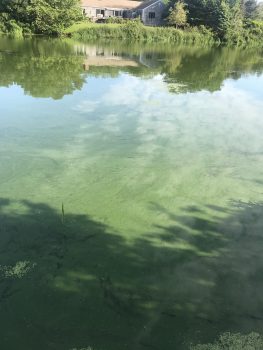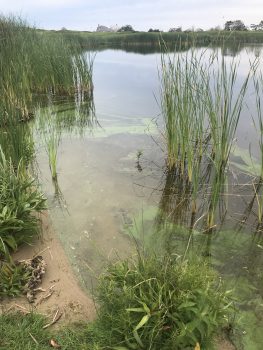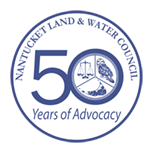The Land Council, through research and professional development at regional and national conferences has begun to take a closer look at the Harmful Algal Blooms (HABs) appearing in a number of our island ponds on a more frequent basis over the past ten years. 
Phytoplankton ID and Enumeration
A regular part of the NLC’s island pond sampling program includes the identification and enumeration of phytoplankton species found within the water column. We prioritize this data collection in order to track the proportion of the phytoplankton population that are cyanobacteria species and to see how that population dynamic changes throughout the season and the years. Determining the phytoplankton species present is also the first step in determining whether or not a HAB could be dangerous. Data and analysis of the phytoplankton communities in each of our studied ponds can be found in our Island Pond Reports.
HABs Evaluation and Toxicity Analysis
As the NLC monitors the water quality in various island ponds we are working with the Town and other conservation organizations to assist with evaluating HABs as they occur and performing additional analysis to identify any potentially toxin producing cyanobacteria species, and if present using off island labs to measure the level of any toxins being produced. This work occurs on a case by case basis as the analysis can be time consuming and expensive. This data helps the Town and property owners asses risk and ensure that all pond access points are properly posted.
HABs Aerosolization Research
The NLC has partnered with off island researchers to further investigate the aerosolization of cyanotoxins in ponds that are experiencing HABs. Stay tuned for more news on this exciting and important research.
Nantucket HABs Reporting and Posting
 The Nantucket Land & Water Council is pleased to be working collaboratively with the Town of Nantucket, Nantucket Conservation Foundation and Nantucket Islands Land Bank to monitor a number of island ponds for HABs on a weekly basis. For more information and to stay informed about local HABs please visit: https://www.nantucket-ma.gov/1792/Harmful-Algal-Blooms-Monitoring-Program
The Nantucket Land & Water Council is pleased to be working collaboratively with the Town of Nantucket, Nantucket Conservation Foundation and Nantucket Islands Land Bank to monitor a number of island ponds for HABs on a weekly basis. For more information and to stay informed about local HABs please visit: https://www.nantucket-ma.gov/1792/Harmful-Algal-Blooms-Monitoring-Program
WHAT IS A HARMFUL ALGAL BLOOM?
HABs can be defined as an elevated concentration of algae that can negatively impact a water body or its uses. All HABs can depress oxygen, alter pH and contribute to the eutrophication of a system.
WHERE DO HABs OCCUR?
HABs can occur in fresh or salt water and can be associated with any group of algae. Different species thrive and bloom in fresh vs marine environments.
WHY ARE HABs A PROBLEM?
While all HABs can negatively impact the health of an aquatic ecosystem, and typically indicate that a water body is already impaired, the greatest human risk comes from blooms of cyanobacteria (also known as blue-green algae) which are known to produce toxins harmful to the health of humans and animals (including dogs). Different species of cyanobacteria are capable of producing different toxins. However, not all cyanobacteria species produce toxins, and even those that can, do not always do so. Toxin production is not guaranteed and its triggers are not well understood.
WHAT KIND OF TOXINS CAN HABs PRODUCE?
Cyanobacteria produce several different classes of toxins including Dermatoxins, Hepatotoxins and Neurotoxins.
HOW DO YOU KNOW IF A HAB IS DANGEROUS?
Harmful Algal Blooms involving cyanobacteria can typically be identified by a blue-green coloration in the water and especially by the presence of a blue-green scum at the water surface and around the shoreline. It often resembles blue-green paint. The World Health Organization, Federal Environmental Protection Agency, and Massachusetts Department of Environmental Protection all have guidance around safe levels of cyanobacteria and/or cyanotoxins in drinking water and recreational waters. For additional information on this guidance see the links below. Whenever a HAB is visible in a water body, all contact with that water should be avoided by humans and pets until the bloom has dissipated.
MORE HABs RESOURCES
https://www.mass.gov/guides/cyanobacterial-harmful-algal-blooms-cyanohabs-water#-what-are-cyanohabs?
